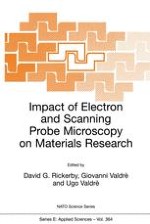1999 | OriginalPaper | Buchkapitel
Convergent Beam Electron Diffraction
verfasst von : Colin J. Humphreys
Erschienen in: Impact of Electron and Scanning Probe Microscopy on Materials Research
Verlag: Springer Netherlands
Enthalten in: Professional Book Archive
Aktivieren Sie unsere intelligente Suche, um passende Fachinhalte oder Patente zu finden.
Wählen Sie Textabschnitte aus um mit Künstlicher Intelligenz passenden Patente zu finden. powered by
Markieren Sie Textabschnitte, um KI-gestützt weitere passende Inhalte zu finden. powered by
Convergent beam electron diffraction (CBED) is one of the most important techniques in electron microscopy and electron diffraction since it provides a wealth of information about the material being studied. The single most important feature of CBED is that it provides localised diffraction information about the specimen from regions which can be as small as only a single atom across. As will be explained later, CBED patterns are formed using an electron beam which is focused onto the specimen. The spatial resolution of the CBED patterns is therefore the minimum size of the focused electron beam on the specimen. In older microscopes this is about 10 nm, but in a field emission gun scanning transmission electron microscope (FEGSTEM) or a field emission gun transmission electron microscope (FEGTEM) the focused probe size is better then 1 nm. In the most recent instruments the focused probe size is approaching 1Å, hence CBED patterns can come from single atomic columns (beam spreading effects due to elastic and inelastic scattering must of course be taken into account when considering the spatial resolution). CBED is an extremely important and useful technique on both older and newer electron microscopes for the reasons outlined below.
